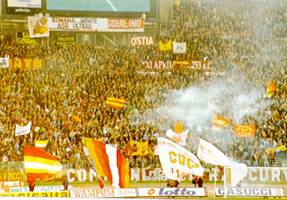|
It took us a moment to figure out, but we were sitting among the Roman faithful. Bari was to our right, concentrated behind the North goal. Their section was packed. They were loud, very, very loud. They couldn’t have been more than 10,000, but when it came to making noise they were a David who seemed determined to outmatch a Goliath, the 50 to 60,000 Roman fans who nearly filled all the remaining sections. If the Bari fans were indignant about being isolated to the most remote part of the stadium, it only fueled their enthusiasm. They maintained a loud, low frequency, rhythmical drone, peppered with momentary higher frequency releases, throughout the game. Frequently they drowned out the massive Roman counterpart, who were none the less passionate. The Romans, in return, would excite themselves to even higher decibels to drown out the Bari incantations. The police, dressed in full riot gear, were always present on the perimeter of the Bari section and were always busy either picking up flares or returning Bari fans to their seats. Bari erupted when an illegal handball in the box brought a Bari player a red card and provided Motello, the Roman stiker, his second goal of the night. If there was no fence, Bari would have stormed the field. I gained an appreciation for one element of the stadium design I’d like to do without. My son, Shani, an avid fan of the international game and player himself, told me that Roma has some Brazilian players that I would recognize. But other than that, I knew nothing, including the position of either team in the standings, the style of play, the history of the rivalry, nothing. Honestly, I really didn’t care who was going to win. I just wanted to see for myself, what a real life Serie A football match was like. I had watched countless matches on TV, but only one in real life and it was way too many years ago. When I first wrote my thoughts about this game, I focused a lot on the football. The tactics of the Roma team were interesting to me because they weren’t classical Italian tactics. Perhaps, they had accommodated for the presence of Aldair, Zago and Cafu of Brasil. I kept logging in the technical notes, noting defensive coverage patterns during the attack, midfield movements, attack approaches in the final third. I became self-conscious that I was out of touch with everyone else and thankful for the fact that I was never outed. My analytical perspective made me the equivalent of a misfit and geek among those who surrounded us. I had missed their point. The real event was not the tactical considerations of the Italian coaches or the individual players. It was the palpable, collective experience of fans who seemed to live and die by each moment, each brilliant move, each disappointment, and each glorious success. There was a young man standing behind me, perhaps only 20 years old, who stood for the whole of the game. He never took his eyes off the field. He sang “grazie Roma,” cheered at every opportunity, moaned at every disappointing event, and held his beloved Roma scarf wide above his head for the whole of the game. His body swayed right and left in cadence with the Roman faithful. He loved his Roma and that’s all that mattered. He was the normal one. I was not. I’m not sure that what we experienced at the Stadio Olimpico has a full equivalent in American sports. A disturbing, dreamy state of mind had been created by the primordial incantations, the monstrous swirling flags, the flares, and the massive eruptions. It was unsettling and wild. A cloud of smoke and swirling moisture hovered about the field. Sometimes the red smoke of a flare would mix in. It all made the game seem more of a fantasy. It distanced me from the reality I was familiar with: the reality of the sweat, pain and energy of the players. It couldn’t have mattered to the fan what the individual player was experiencing on the field of play. It was irrelevant. Only one thing mattered: what was the consequence of the player’s effort? This was 90 minutes of collective love and hate. Love for your team and hate for the opponent. Can the American fan give as much of himself? American intercollegiate football and basketball have strong rivalries and the games are emotion-filled events. But does anyone really feel as deeply about its college team the way a Roman or Bari fan feels about its football team? There is something more deeply rooted here. It’s brain stem stuff, not cortical. I’ve never seen a Texas High School American Football game, but I’ve heard about them. High school kids represent their town in the rivalry against the next town for bragging rights that will go on and on until the next time the two teams meet. That’s a little bit what it was like in Roma, but then add more bodies, more passion, more years of devotion, more flags in the air, more songs, more tears, more joy, more flares. |
Il Mistero Italiano – Watching Roma in Rome Part 4












 I became somewhat concerned that the Roma fans we were sitting amongst might figure out that we really weren’t fans who had come to support their team. It was obvious that everyone in the stadium, except for us, took one side or the other. You either sit with the Romans or you sit with the Barians. There was no section for the neutral fan. What if we were found out? I would never have chanced an expression of neutrality, but if the Roman fans in our section knew what I was thinking I’m sure I’d be welcomed like a witch at High Mass. My problem was that I didn’t know one team from the other.
I became somewhat concerned that the Roma fans we were sitting amongst might figure out that we really weren’t fans who had come to support their team. It was obvious that everyone in the stadium, except for us, took one side or the other. You either sit with the Romans or you sit with the Barians. There was no section for the neutral fan. What if we were found out? I would never have chanced an expression of neutrality, but if the Roman fans in our section knew what I was thinking I’m sure I’d be welcomed like a witch at High Mass. My problem was that I didn’t know one team from the other. 


